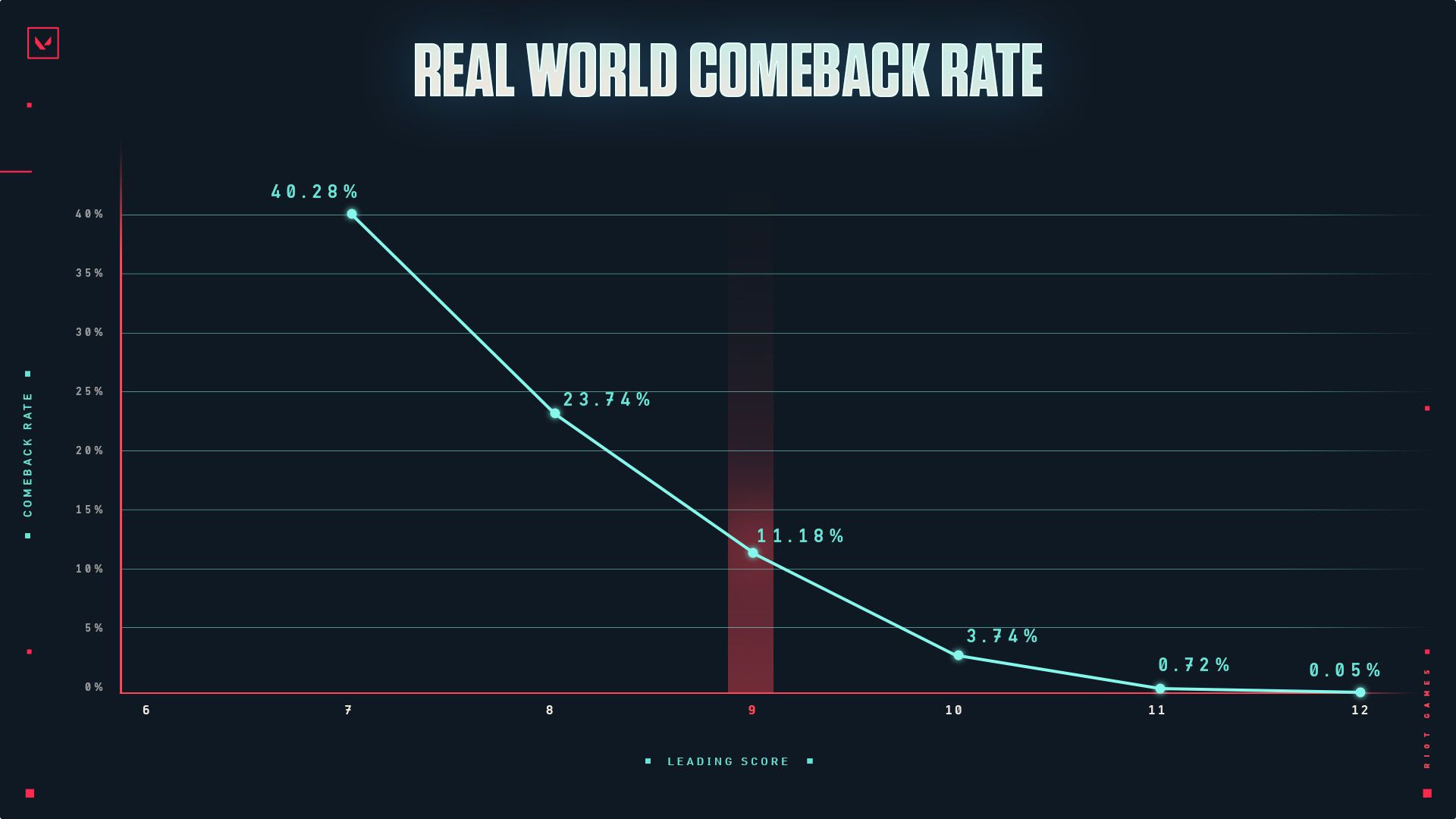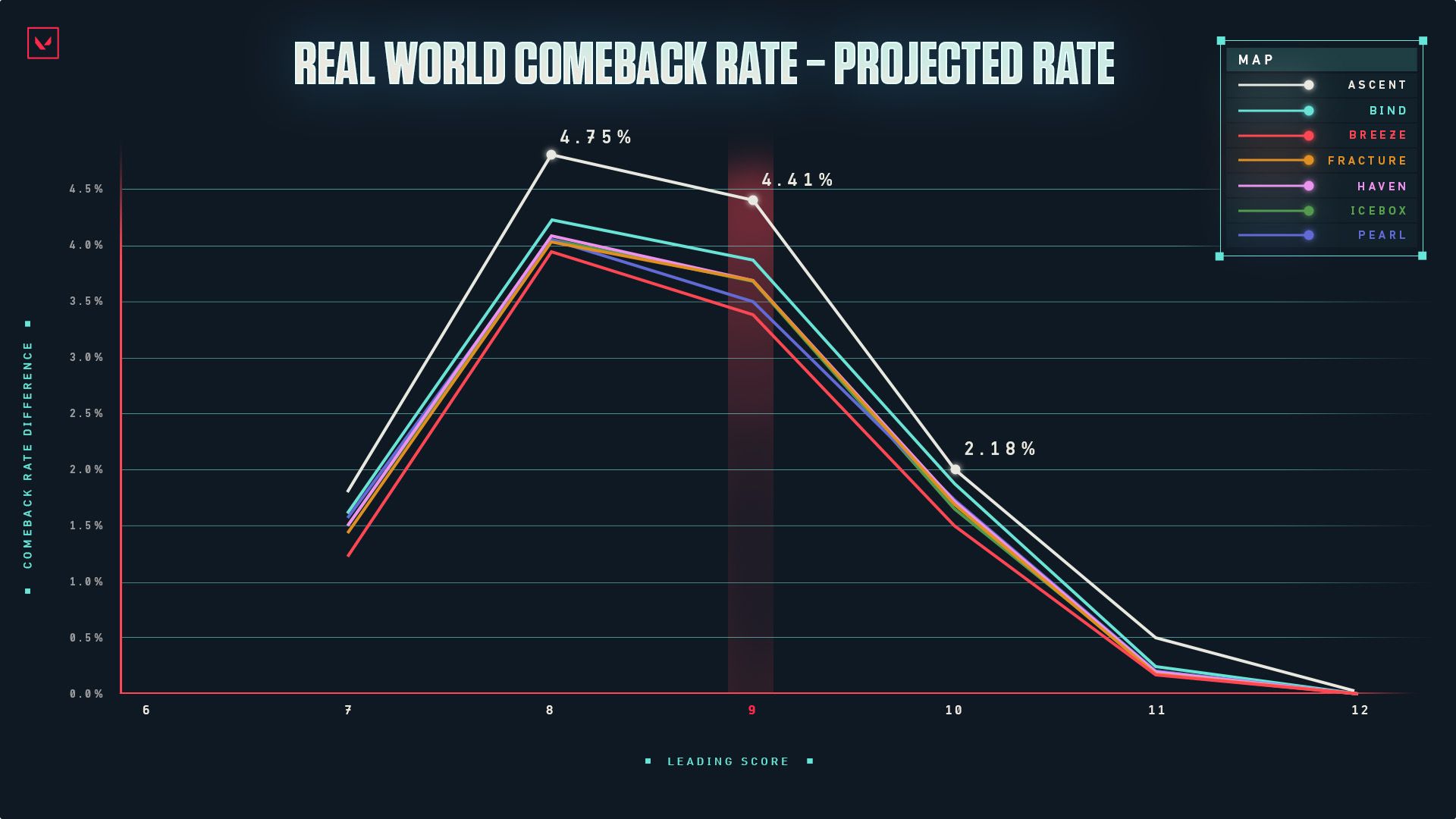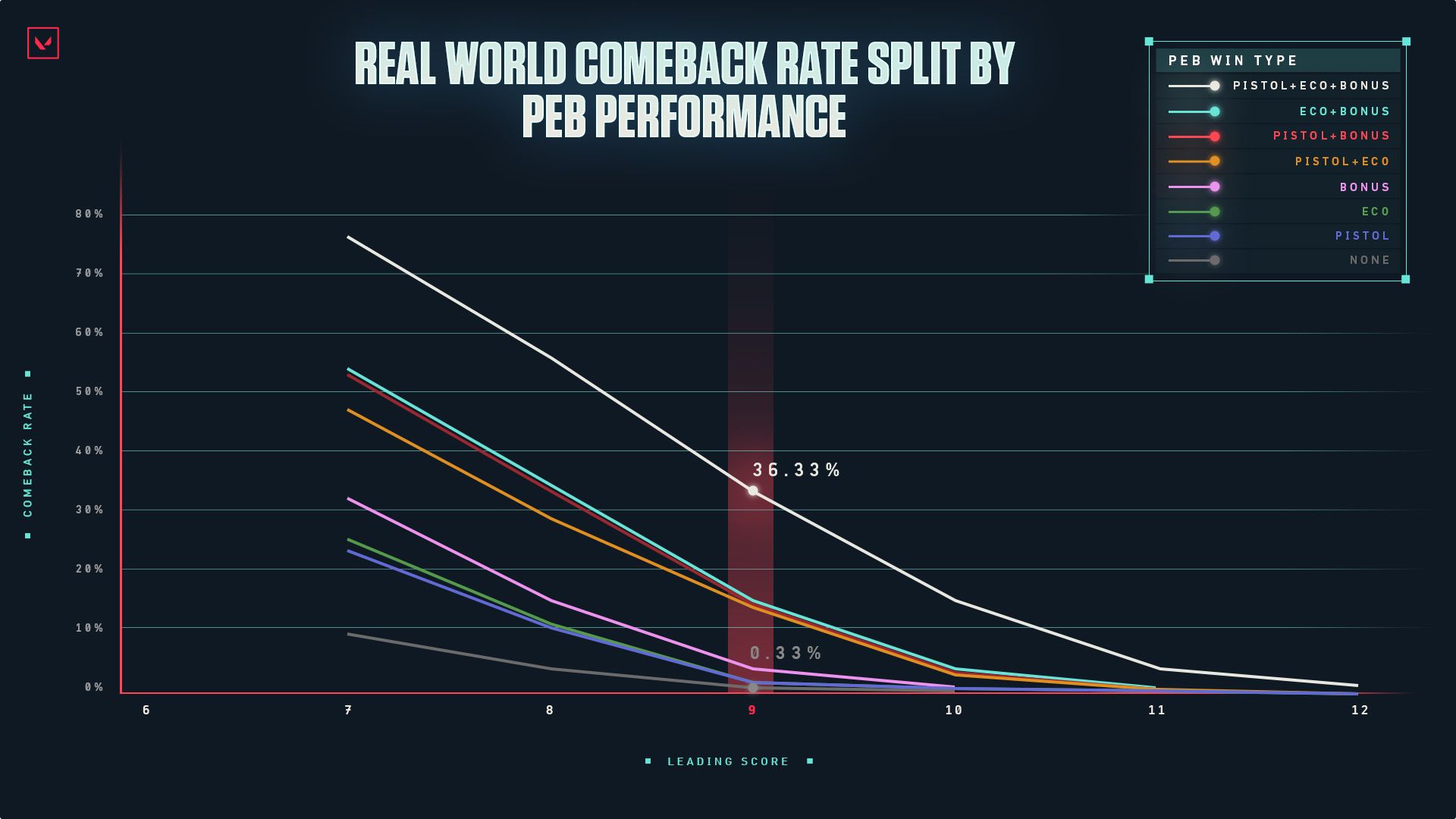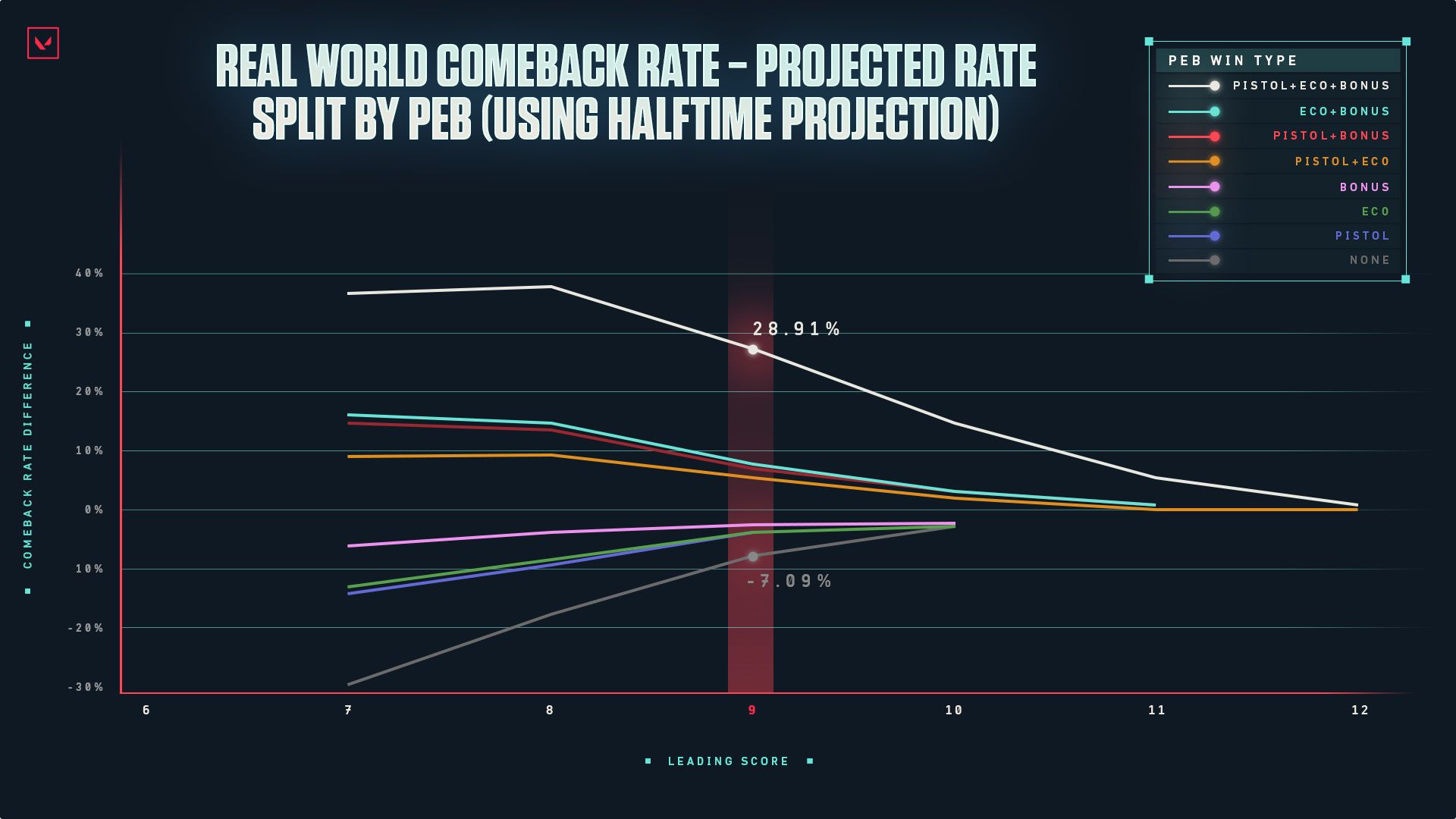VALORANT Data Breach: 9-3 Curse
If you’ve been playing VALORANT for a while, you’ve probably heard the phrase “9-3 curse” in at least one of your games. Or maybe even during a Champions match. But don't just take our word for it—here’s a clip of Shroud talking about the curse during a VCT match from last year.
So what is it? Why do people talk about it? And is it real? Let’s find out.
Welcome to the VALORANT Data Breach.
What is the “9-3 Curse?”
Somewhere in the years since VALORANT’s release, the legend of the 9-3 curse was born. Believers in the curse quickly turn to panic mode when they enter halftime with a leading score of 9 round wins to 3. The “curse” being that the team with the 3 round wins has an unusually high chance to come back and either win the whole game, or bring it back to a 12-12 tie, leading to an overtime.
So what does the actual data say?
By The Numbers
For the purposes of this article, the VALORANT Insights team gathered data from a query that examined over 25 million competitive matches. A nice, juicy sample size.
So first, let’s look at a simple graph—Real World Comeback Rate, or the rate at which the teams in our sample were able to mount a comeback when behind at the half. For this article, we considered a comeback to be either a 13-round win or a forced overtime by the team that was trailing at the half, regardless of whether that team won or lost in OT.
When we look at the average comeback rate of a team in relation to the number of rounds that team is trailing at the half, we start to see a pretty obvious trend.
For example, a team that’s trailing 5-7 at the half still wins or forces overtime 40.28% of the time. And a team that’s down 0-12 only pulls off a reverse sweep to win or force OT 0.05% of the time—approximately a 1 in 2000 chance. Oof.
This chart shows that in over 25 million games, teams trailing 3-9 at the half only have an 11.18% chance to tie or win by the end of the game. But that's just the tip of the iceberg.
Digging Deeper
An 11.18% chance to lose a 9-3 lead doesn’t seem like quite enough to spark up rumors of a curse.
So the Insights team decided to conjure up some mathematical wizardry to create projections for how a team should theoretically perform in a given situation. These projections help us find out how much better or worse teams are performing compared to the mathematical odds against them.
For the projected rates in this second graph, the team looked at factors like map, attacking/defending side, and rounds-won at halftime. Then, they looked at the actual win rates observed in those 25 million+ comp matches.
For example, according to the calculations, a team trailing 4-8 at the half on Ascent should have a Z% chance to win the game. But when we looked at the numbers, we found that players were actually winning Z+4.75% of the time. Basically, teams are beating the odds by nearly 5 percentage points. Here’s where things start to get interesting.
If you look at the two graphs above, one would expect them to follow a similar downward trend as the overall comeback rates—the more rounds you’re behind, the less likely you are to beat the odds. But what we actually see is a big hump with 8-4 and 9-3 scores. And the differences between 8-4 and 9-3 are surprisingly close.
As we said, teams trailing 4-8 beat the projected odds 4.75% of the time more often than they should. And teams trailing 3-9 beat those odds 4.41% of the time. This is more than twice the jump in odds than we see at 7-5 or 10-2 and it accounts for that peak in the data with 9-3 and 8-4 scores.
So what’s going on?
Cash Rules Everything Around You (Dolla Dolla Bills, Y’all)
There’s a lot of talk about the economy these days, and VALORANT is no exception. The Insights team had a hunch that econ was playing a big role in 9-3 curse perception since each team gets a big economic reset at the half.
And since our projected numbers in the previous section cannot factor in either team’s economy, the team wanted to take a closer look at our real world data to see how an economic advantage or disadvantage could change the outcome of a game—especially when a 9-3 score was recorded at the half.
Because the first few rounds of each half are often played in a very similar way, the team knew it would be important to capture how the outcomes of these rounds affect the odds. And when we visualize the data, it starts to paint a very clear picture of just how crucial that halftime econ reset actually is.
So let’s look at the real world comeback rate for trailing teams based on some different halftime-reset win conditions in relation to their starting score at the half. According to the data, the odds of a comeback increase or decrease dramatically depending on how well a team performs in what we internally refer to as the P.E.B. rounds—the pistol round that starts the half, the following eco round, and/or the bonus income round.
From that graph, we can see that in 25M+ competitive games, teams who were trailing 3-9 only won 0.33% of games when they lost all three P.E.B. rounds at the half, effectively making their score 3-12. And on the flip side, 3-9 teams who won the pistol, eco, and bonus rounds win 36.33% of games and bring their score to 6-9 with a very large economic advantage. That’s a more than a 1 in 3 chance to win the game when trailing 3-9 if you win the first three rounds at the halftime switch—raising your odds to win by over 100x when compared to winning no P.E.B. rounds.
Now that’s starting to look much more common than we thought. With these numbers in-mind, we can start to make some even better predictions.
Prioritize the P.E.B.
Once again, these numbers look pretty definitive when viewed in a statistics vacuum. But that’s not what statisticians do. It’s important to apply more context, rather than just interpreting the raw data alone. So the Insights team conjured up some more mathematical projections that factor in variables like map, attacking/defending side, and halftime score.
And the comparisons between the projected comeback rates and real world comeback rates confirmed that the halftime reset is no joke. For teams trying to flip the script, prioritizing P.E.B. rounds is serious business.
For example, we already mentioned that a team that’s trailing 3-9 at the half has an 11.18% chance of winning the game or forcing an OT. But if that same team manages to win all P.E.B. rounds, they end up winning Z+28.91% of their games, where Z is their projected odds to win at halftime. On the flip side, if that team loses all three rounds, their win rate plummets to Z-7%.
So sweeping or getting swept in the P.E.B. rounds means the difference between a healthy 1 in 3 chance to mount a comeback, or a dismal 1 in 300 chance to do so.
Soo… 9-3 Curse—Real or Myth?
Answer: It’s complicated.
If you’re one of those players who thinks a 9-3 lead is an automatic loss, then it’s safe to say, sorry—myth busted. But if your idea of the curse is simply that something feels weird about a 9-3 halftime score, then yes, you might be onto something.
From the numbers, we can confidently state that your overall chances of winning a game when trailing 3-9 are much lower than the chances of the other team (and also much lower than if you were down 4-8 instead). But that does come with some caveats.
As we saw in the second graph, the real world trends for 9-3 scores are a liiiittle different from their projections in relation to the others scores on the graph. So something is happening when a 9-3 score occurs at the half. But what?
Are winning teams getting spooked? Are trailing teams getting motivated? Is it all about the economy?
We gave our primary researcher, Ash “Riot Kona” Garrett, the last word on their findings.
“I personally don’t think there’s anything inherent to a 9-3 score that causes players to lose games. Rather, it’s probably more likely that players are overestimating the safety that a 9-3 lead provides,” Ash said. “According to our projections, a 9-3 lead shouldn’t actually be too uncommon between evenly matched teams. We might have cases of leading teams seeing a skill diff that actually isn’t there and getting a little too comfortable, while trailing teams are taking advantage of both an economic and mental reset—with a little help from the myth of the ‘curse.’”



